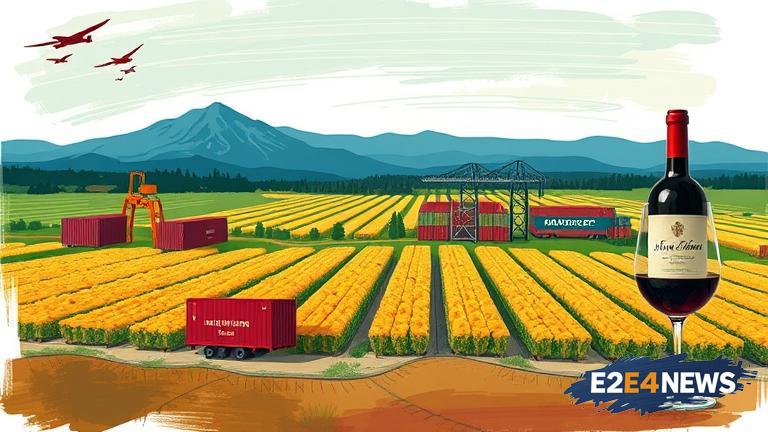The California wine industry, renowned for its high-quality wines and significant economic contributions to the state, is facing a new challenge with the introduction of tariffs on wine imports and exports. The tariffs, imposed by the US government, aim to protect American wine producers from foreign competition. However, the impact of these tariffs on the California wine industry is complex and multifaceted. On one hand, the tariffs may help protect local wine businesses by reducing the influx of cheap, imported wines that could potentially undercut California wines in the market. This could lead to increased sales and revenue for California wine producers, allowing them to invest in their businesses and create more jobs. On the other hand, the tariffs may also lead to significant economic losses for the industry, particularly for wineries that rely heavily on exports. Many California wineries export a substantial portion of their production to countries like China, the European Union, and Canada, and the tariffs could make their wines more expensive and less competitive in these markets. This could result in reduced sales and revenue, forcing some wineries to downsize or even close their operations. Furthermore, the tariffs may also lead to retaliatory measures from other countries, which could further exacerbate the situation. The European Union, for example, has already imposed its own tariffs on American wines in response to the US tariffs, which could lead to a trade war that would have far-reaching consequences for the global wine industry. In addition to the economic impacts, the tariffs may also have social and environmental implications. Many California wineries are family-owned and operated, and the tariffs could lead to the loss of livelihoods and cultural heritage. The tariffs may also lead to increased prices for consumers, which could reduce demand for wine and lead to a decline in the industry as a whole. The California wine industry is not alone in its concerns, as other industries such as agriculture and manufacturing are also affected by the tariffs. The state government has been working to mitigate the impacts of the tariffs, including providing support to affected businesses and advocating for a resolution to the trade disputes. However, the situation remains uncertain, and the long-term effects of the tariffs on the California wine industry are still unknown. Some experts argue that the tariffs are a necessary measure to protect American industries, while others claim that they are a misguided policy that will ultimately harm the economy. As the situation continues to evolve, it is clear that the tariffs will have a significant impact on the California wine industry, and it is essential to monitor the situation closely and adapt to any changes. The industry must also work together to find solutions and support each other during this challenging time. In conclusion, the tariffs on wine imports and exports have created a complex and uncertain situation for the California wine industry. While some argue that the tariffs will help protect local businesses, others claim that they will lead to significant economic losses. As the industry navigates this challenging time, it is essential to consider the potential impacts and work together to find solutions. The future of the California wine industry depends on it. The tariffs have also sparked a debate about the role of government in regulating trade and protecting domestic industries. Some argue that the government should play a more active role in protecting American businesses, while others claim that the tariffs are an example of protectionism that will ultimately harm the economy. The situation highlights the need for a nuanced and informed discussion about trade policy and its impacts on different industries. The California wine industry is a significant contributor to the state’s economy, and any policies that affect the industry will have far-reaching consequences. As the situation continues to unfold, it is essential to consider the potential impacts and work towards finding solutions that benefit the industry and the state as a whole. The tariffs have also raised questions about the impact of globalization on local industries. While globalization has created new opportunities for trade and economic growth, it has also led to increased competition and challenges for domestic businesses. The California wine industry is not immune to these challenges, and the tariffs have highlighted the need for the industry to adapt to changing market conditions. In order to remain competitive, the industry must invest in innovation and marketing, and work to differentiate its products from those of other countries. The tariffs have also sparked a discussion about the role of technology in the wine industry. Some experts argue that technology, such as e-commerce and social media, can help wineries reach new customers and increase sales. However, others claim that technology is not a substitute for traditional marketing and sales strategies. The situation highlights the need for the industry to invest in a range of marketing and sales strategies, including technology, in order to remain competitive. The tariffs have also raised questions about the impact of climate change on the wine industry. Climate change has led to increased temperatures and changing weather patterns, which can affect grape yields and wine quality. The tariffs have highlighted the need for the industry to invest in sustainable practices and adapt to changing environmental conditions. In conclusion, the tariffs on wine imports and exports have created a complex and uncertain situation for the California wine industry. While some argue that the tariffs will help protect local businesses, others claim that they will lead to significant economic losses. As the industry navigates this challenging time, it is essential to consider the potential impacts and work together to find solutions. The future of the California wine industry depends on it.
